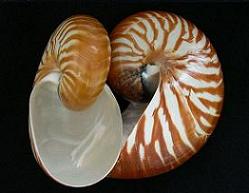Examples: Cephalopods


Chambered Nautilus (helmet shape, [2, p. 248])
[alpha=80, beta=90, phi=0, mu=0, Omega=0, A=2, a=2, b=1.5, L=0]
(Click with the mouse over the picture to rotate it)
In old times, cephalopoda (class that includes octopus, cuttlefish, spirula, squid and nautilus)
were one of the most numerous class of invertebrates of the sea; now, only some species survive, mainly
in the seas of the Indo-Pacific region. The nautilus is a thin and light shell coiled in flat spiral. The interior has chambers serving as buoyancy tanks
allowing the animal to change depth (they migrate vast distances up and down daily). It dwells deep along the steep slopes of Pacific Ocean coral reefs to avoid
predators active above during the day. But at night it slowly rises, adjusting gas pressure in its chambers. Once it reaches its preferred depth, it pursues
crustaceans using rapid jet propulsion, swimming as its powerful muscles expel water previously taken in.
Habitat: free swimming, Indo-Pacific waters mainly.
[2] S. Peter Dance, Shells, Dorling Kindersley, 2002.



